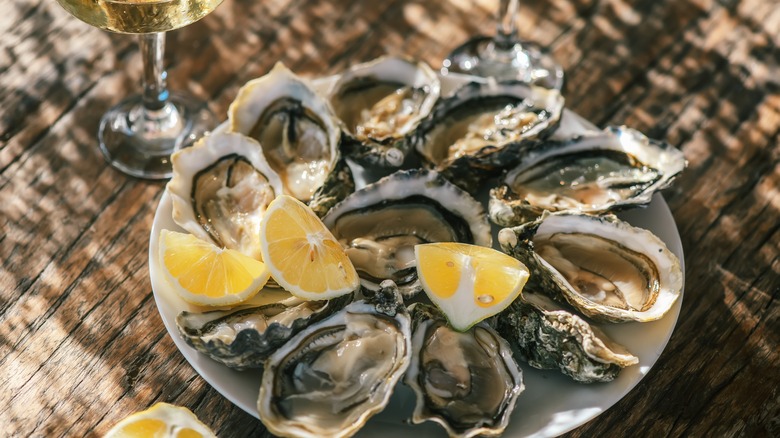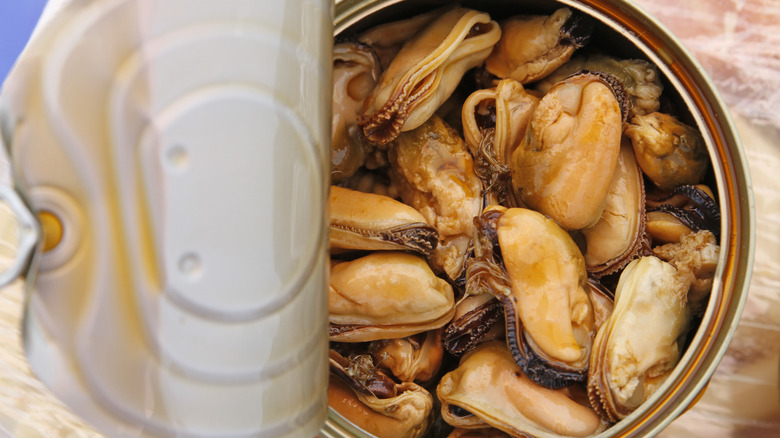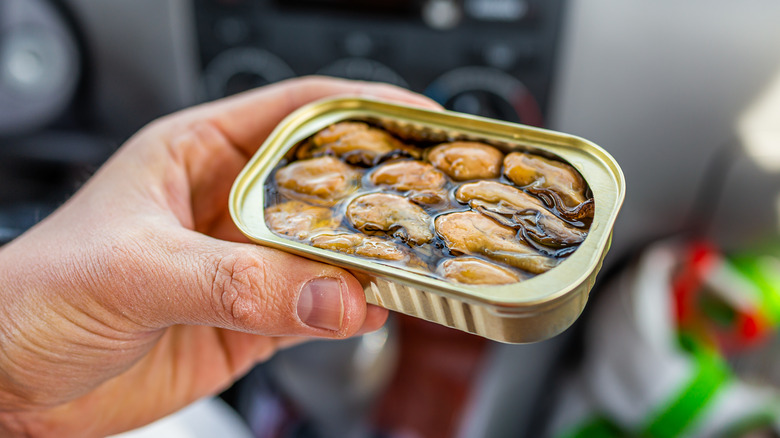The Right Time To Use Canned Oysters Vs Fresh
We may receive a commission on purchases made from links.
A fresh oyster is a thing of beauty. Whether slurped, fried, or grilled (oysters are unexpectedly succulent on the grill), the saline-mineral sweetness of the rich flesh can not be beat. And yet, there are canned and jarred shucked oysters just sitting there on store shelves. Why? In a sense, they're not really worth the lower price tag, since the canned versions are so different from the fresh, and pale in comparison when it comes to texture and mouthfeel. But the fact is, canned versions — plain or smoked — serve useful, delicious functions in a variety of dishes.
It's worth noting that the proper time to eat fresh oysters is any time. Shucked live, and as fresh as possible, they are the perfect appetizer with a little vinegar or a dash of hot sauce. They're also the best option when the brine is important, whether it's so they cook in their own juices in the oven or on the grill, or you're making oyster luges with Scotch whisky. Canned oysters, on the other hand, tend to work best when they're not the featured ingredient, or when you need a quick, easy way to upgrade an appetizer without heading to the fishmonger.
Canned plain oysters are a versatile ingredient
Slurping canned (or jarred) plain oysters can be somewhat unsatisfying, as they are mushier and less briny than fresh ones. But where they stand head and shoulders above their live counterparts is in convenience. Buy a few cans, stick them in the pantry, and forget about them. When you're craving pan-fried oysters, or it's time to put them in a soup, they will save both time (no shucking) and money. A basic can of oysters, like Bumble Bee whole oysters (packed in water) run around four dollars, and you'll get roughly the equivalent of a half-dozen large, or 40 or more small oysters. Or buy a can of MW Polar oyster pieces, and you don't even need to chop them up.
But what can you do with them? As most canning companies steam or boil the oysters before canning, these bivalves are milder and broken down to a softer texture than live oysters, making them even tastier in a classic oyster and egg skillet (highly recommended if you haven't done this for breakfast). Oysters canned in water are easier to pat dry than their "slimy" fresh counterparts, which works perfectly for making fried oysters in the air fryer. Canned oysters are also a perfect addition to fall soups, whether it's a classic oyster soup or chowder.
Tinned smoked oysters are a delicacy on their own
Smoked oysters, in the flat, oval cans, are completely different from the plain canned oysters mentioned above. These tinned oysters are shucked and smoked, then packed in oil. They are closer to tinned sardines or anchovies. Arguably, they're one of the best canned meats you should have in your pantry. Each oyster (there are about a dozen per can), is a smoky, chewy burst of flavor. They can be enjoyed on their own or incorporated into appetizers (think crackers or cucumber slices, cream cheese, and a smoked oyster, with fresh dill on top). While the standard grocery store options are fine, it's nice to go fancy here. Consider Ekone smoked oysters from Washington state.
But their versatility goes beyond a quickie appetizer. Smoked oyster cornbread dressing, for example, is a Southern delicacy that needs to be enjoyed beyond the holidays. They also work, finely diced, as a complex replacement or accompaniment to bacon in pasta carbonara. The savory, smoky, chunks of oyster work well to enhance anything from a Niçoise salad (one of Martha Stewart's favorites) to a classic muffaletta, upgrading the chopped olives by adding the oysters. The point is that there's no reason to think of canned, jarred, or tinned oysters as a cheap, inferior alternative. Instead, consider the strengths and weaknesses of fresh and canned oysters.


